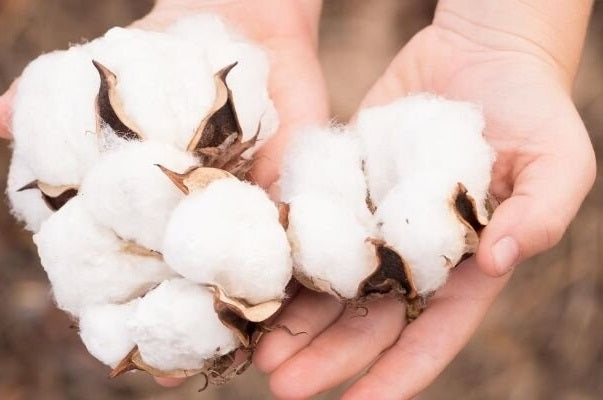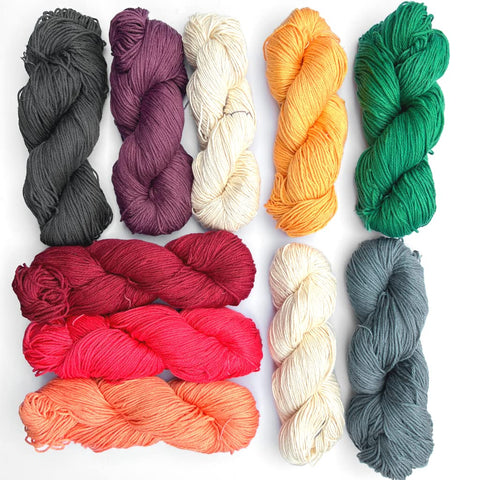As a knitter, we’ve probably all made the mistake of getting half way through a project before realizing we’ve purchased the wrong type of yarn. Thus learning that before beginning any knitting project, it’s important to be knowledgeable about the properties of your knitting fiber. In this article, we’ll talk about the properties of cotton, and what type of knitting projects typically utilizes those projects best.

If you don’t have cotton yarn in front of you right now, the most common household item you can take a close look at is a cotton ball. If you look closely, you can see the cotton ball is made up of very fine, hair-like fibers. Each single hair (fiber) is a single cell, which combined make up cotton itself. Of all the natural fibers that have been industrialized, cotton is the most widely used and produced.
What are natural fibers you might ask?
Natural fibers are fibers that originate organically from animals or plants. Some very popular examples of natural fibers are cotton, wool and silk. But while these three are natural fibers, cotton originates from plants, while both silk and wool originate from animals.

Where is Cotton produced?
The United States has always been one of the largest global producers of cotton. The top three producers by country are China, India, and the United States. The graphic below depicts the 17 states within the USA where cotton is grown, with Texas being the leading cotton producing state. Raw cotton from these states is harvested, spun and twisted, and then made into yarn. This process intertwines the fibers and gives the cotton yarn its strength.

Now that we’ve established a basic background about cotton, lets cover some of cottons properties.
Properties of Cotton Yarn
- Cotton Yarn is easily dyed
- Cotton yarn shows every stitch in great detail
- Cotton is a very strong & durable fiber, whether it’s wet or dry
- Cotton is capable of absorbing up to 25x its weight in water, while also allowing water to evaporate at a faster rate than other fibers
- Cotton is soft and lightweight, pulling heat away from the body making cotton clothing comfortable to wear throughout the year
Things to know before knitting with cotton yarn
- 100% cotton yarn may be slightly stiffer than other yarns or blends
- Because cotton holds water better than other fibers, it is also prone to stretch and sag. Once it has stretched, it won’t fully return to its original size.
- Cotton has no elasticity, which could impact ability to maintain even knitting tension
Now that we’ve explored some of the properties of cotton lets get to the fun part!
Why Knit with Cotton Yarn
As we mentioned above, cotton yarn is incredibly soft, beathable, accepts dye beautifully and is so very versatile for knitters. Many knitters who live in mild climates enjoy cotton clothing year-round, and importantly, it is the best alternative for those knitters that have wool allergies. If you’re looking for undyed cotton yarn to experiment dying, we have the perfect option for you below!
Uses of Cotton Yarn
Because of its softness, absorbency, vibrant coloring after dye and easy care instructions, cotton is a go-to fiber for many knitting and crochet projects
Wear It
Globally, cotton is the most worn fiber in the world due to its comfortableness and cost effectiveness, and relatively easy production. Particularly if you’re knitting Spring, Summer and Autumn clothing, consider using cotton yarn. It’s soft, breathable and does a great job of wicking moisture away from the body which makes it great for next to skin projects including but not limited to, knit tanks, t-shirts, tunics, shells, pullovers and cardigan sweaters.
Use It Around the House
Cotton yarn is great for knitting household items like rugs, pillows, towels, carrying bags, washcloths, pot holders, and by far the MOST popular household item: Dishcloths.
Best for Baby
Cotton is a fabulous choice for all garments related to babies because it is easy to care for, and available in many vibrant colors (see some of our solid color and multicolor cotton yarn options below) Enjoy cotton yarn for knitting or crocheting baby blankets, baby clothes, booties, and layettes.
Is Cotton Yarn Stretchy
One of the cons of cotton is that it’s not particularly stretchy. This can make it a little more challenging to knit, and keep in mind that if knitting with cotton, you may need to go down a size
Caring for Cotton
One of the biggest pros of cotton is on the care side. It’s very easy to care for, you can simply machine wash almost every type of cotton yarn, or if you’re the cautious type, you can hand wash and lay flat to dry. You can also iron our cotton yarn garment, as well as steaming to reduce any wrinkles!
Should Cotton Yarn be used for Socks?
Because Cotton fibers don’t have a lot of elasticity, it’s not the best option for knitting socks. While they might look really nice, they aren’t very functional, they’ll be loose and won’t conform to your foot, ultimately causing them to slide right off! If you’re intending to knit socks, instead of cotton yarn choose a yarn such as Merino wool yarn. We have a lot of great options for knitting socks (including actual sock kits here).
To browse our offerings of cotton yarns, click here.
To browse our entire yarn offerings click here.
We hope this article was informative for you, and happy knitting ahead!




